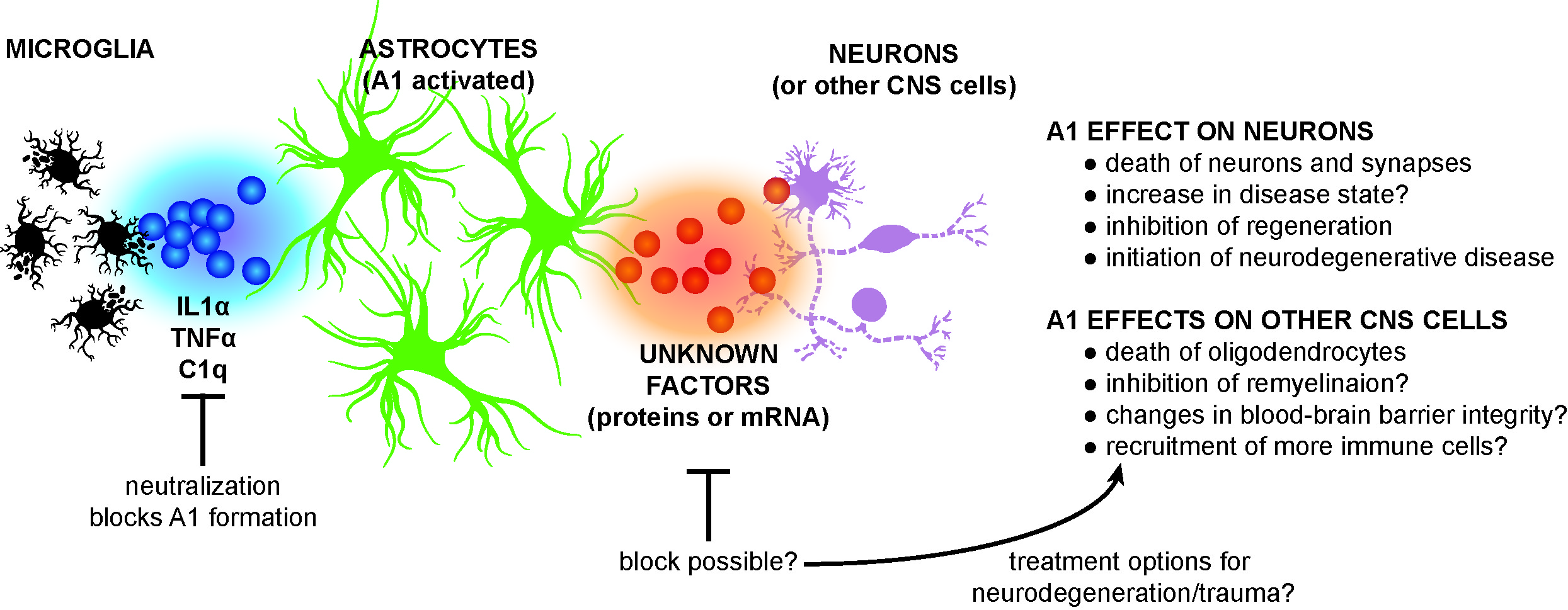We propose that by modulating the activation state of the brain and spinal cords support cells, astrocytes, we can ameliorate a wide range of neurological diseases (eg. Alzheimer's Disease, Huntington's Disease, Multiple Sclerosis) and trauma.

Disease indication- Neurodegenerative diseases [including Alzheimer’s disease, Parkinson’s disease, Amyotrophic Lateral Sclerosis (ALS), multiple sclerosis (MS), Huntington’s Disease] and neuronal injury (including spinal cord injury and glaucoma).Drug format- Initial studies were performed with neutralizing antibodies. However, any type of inhibitory molecule should have similar effects.Drug class- First-in-class approach (preventing formation of neurotoxic astrocytes) could be achieved by repurposing existing antibody drugs or with new molecules. In addition, drugs could be developed to block the specific neurotoxic factor produced by the astrocytes.
- Preclinical in vitro and in vivo data for the following conditions
Alzheimer’s disease - The inventors demonstrated that A1 astrocytes are present in mouse models of Alzheimer’s disease, matching findings in humans.
Amyotrophic Lateral Sclerosis (ALS) - The inventors knocked out the A1 neurotoxic reactive astrocyte phenotype in a mouse model of ALS and increased the life span by ~50%.
Glaucoma/Retinal injury - The inventors demonstrated they can preserve neuronal health in a mouse model of glaucoma/retinal ganglion cell injury by blocking the formation of A1 astrocytes.
Parkinson’s disease - The inventors demonstrated that blocking A1 astrocyte conversion is neuroprotective in models of Parkinson’s disease.
Spinal cord injury - The inventors demonstrated that neutralizing antibodies to IL-1a, TNFa and C1q could block the formation of A1 astrocytes in a rat model of spinal cord injury.
Continued research - The inventors are continuing their work to identify and characterize the specific neurotoxic factor released by activated astrocytes.Target- The neuroprotective drug cocktail would target three different cytokines: tumor necrosis factor alpha (TNF-a), interleukin 1 alpha (IL-1a) and complement component 1q (C1q). In addition, potential new drugs could be identified that directly target the neurotoxic factor produced by reactive astrocytes.Background- Astrocytes are support cells that are essential to the survival and healthy function of neurons. Central nervous system disease or injury can rapidly transform these resting support cells into reactive astrocytes. The inventors discovered that, in a neuroinflammatory response, the three cytokines IL-1a, TNF and C1q are necessary and sufficient to induce "A1 astrocytes," a subtype of reactive astrocytes. The A1 astrocytes no longer promote neuronal survival but instead induce the death of neurons and oligodendrocytes. In addition to being induced after acute CNS injury, A1 astrocytes are abundant in various human neurodegenerative diseases, including Alzheimer’s disease, Huntington’s disease, Parkinson’s disease, ALS and MS. In summary, neurotoxic, reactive A1 astrocyte formation is a fundamental pathological response to neuroinflammation, acute CNS injury and many neurodegenerative diseases. These cells secrete a neurotoxin that induces rapid death of neurons and oligodendrocytes and may contribute to neurodegeneration and help drive disease progression.Mode of action- Drugs that prevent A1 formation, promote A1 reversion or block the A1 neurotoxin could provide neuroprotection to treat a variety of chronic neurological diseases and acute CNS injuries. Using antibodies or other molecules to inhibit the three cytokines that induce A1 astrocytes could deactivate these neurotoxic cells. In the case of injury, these drugs could potentially save axotomized CNS neurons after spinal cord injury and promote regeneration by stimulating growth and allowing these astrocytes to clear myelin debris. In the case of multiple sclerosis, these drugs could potentially protect oligodendrocyte precursor cells, enabling remyelination of damaged neurons. In the case of other neurodegenerative diseases, these drugs could directly protect neurons to ameliorate progression and symptoms of Alzheimer’s disease, Parkinson’s disease and other disorders of aging. An alternative strategy to prevent the damaging effects of A1 astrocytes would be to directly inhibit the neurotoxic factor that they produce. Together, these strategies would promote neuronal survival in a wide variety of neurological disorders.
 NEUROTOXIC REACTIVE ASTROCYTES ARE INDUCED BY ACTIVATED MICROGLIA. In response to a wide range of neuroinflammatory and genetic conditions, microglia release interleukin 1alpha (IL1a), tumor necrosis factor alpha (TNFa) and complement component C1q. These three factors are sufficient and required to activate astrocytes to an 'A1' neurotoxic phenotype. Activation can be blocked using neutralizing antibodies to IL1a, TNFa, and C1q. A1 astrocytes lost most normal astrocyte functions (failure to produce and maintain synapses, failure for correct synapse pruning, etc.), and become highly neurotoxic - killing mature neurons and oligodendrocytes, but not other cells in the central nervous system. Targeting A1 astrocyte activation, or blocking release of disease-associated astrocyte-derived factors (e.g. the as-yet-unknown neurotoxin).
NEUROTOXIC REACTIVE ASTROCYTES ARE INDUCED BY ACTIVATED MICROGLIA. In response to a wide range of neuroinflammatory and genetic conditions, microglia release interleukin 1alpha (IL1a), tumor necrosis factor alpha (TNFa) and complement component C1q. These three factors are sufficient and required to activate astrocytes to an 'A1' neurotoxic phenotype. Activation can be blocked using neutralizing antibodies to IL1a, TNFa, and C1q. A1 astrocytes lost most normal astrocyte functions (failure to produce and maintain synapses, failure for correct synapse pruning, etc.), and become highly neurotoxic - killing mature neurons and oligodendrocytes, but not other cells in the central nervous system. Targeting A1 astrocyte activation, or blocking release of disease-associated astrocyte-derived factors (e.g. the as-yet-unknown neurotoxin).

